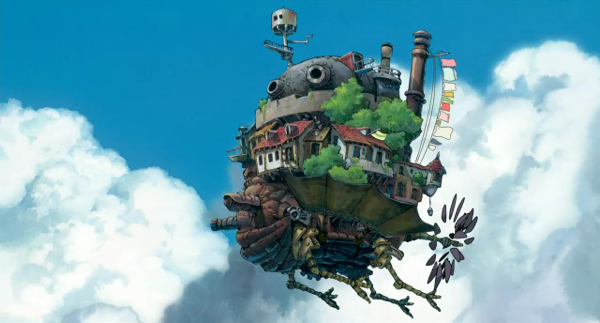Movie review by Greg Carlson
Loosely based on a popular novel by Diana Wynne Jones, “Howl’s Moving Castle” is the latest Hayao Miyazaki feature to manage a wide theatrical release in America. Not since Walt Disney’s golden age has a particular style of storytelling been so indelibly identified with a unique and beloved animation auteur. Rightly or wrongly (according to many of his fans), Miyazaki invites regular comparison to Disney, and the parallel is apt, considering the simultaneous awe and frustration aroused by both masters. “Howl’s Moving Castle” certainly ranks with Miyazaki’s finest films, and despite the often crude dubbing from Japanese to English, the movie should be enjoyed on the big screen.
Taking place in a fantasy realm that evokes aspects of Great Britain as well as other Western European locales, “Howl’s Moving Castle” presents a war-torn kingdom crippled by punishing air raids. Miyazaki’s well-known pacifism might be the movie’s most consistent theme, and the spectacle of gigantic ships raining down bombs hauntingly recalls WW II-era newsreels. Despite the hostilities, a teenage milliner named Sophie (voiced by Emily Mortimer and Jean Simmons) runs afoul of a seemingly wicked witch (Lauren Bacall), who transforms the beautiful youngster into a stooped nonagenarian. Initially seeking an end to her curse, Sophie becomes the housekeeper of Howl (Christian Bale), a vain, brooding wizard.
Howl dwells inside an incredible invention. Perched atop a set of mechanical legs that resemble the feet of a chicken, Howl’s castle is a triumph of design. Equally inviting and foreboding, the castle seems cobbled together out of scrap pieces of metal, glass, and wood. Inside, the dimensions often suggest a homespun domesticity, just as the exterior can bring to mind a cloudbank fashioned of steel and rivets. The cherry on this keep’s sundae is a color-coded dial that allows its operator the magical ability to open the door and suddenly arrive in any number of different locations.
Once Sophie takes up residence inside the ambulatory manse, her aging-curse takes a backseat to several other stories, not all of them particularly satisfying. Miyazaki’s films often bobble the ball when it comes to narrative coherence, and younger viewers (along with plenty of older ones) will have a difficult time sorting out exactly what is supposed to be important. Miyazaki’s vision, however, is so stunning, it is easy to forgive the inconsistencies that confuse the primary events as they unfold. It is a shame that more is not done with Sophie’s dilemma, considering the depth of potential commentary on the positives and negatives of growing old.
Miyazaki die-hards and purists will elect to purchase the DVD with the original Japanese soundtrack, and it is little wonder given some of the awkward voiceovers in the American version. While Bacall and Simmons are almost always right on the money, Christian Bale occasionally overdoes it (adopting tones not unlike his weird, robotic Batman voice). The biggest deficit is Billy Crystal as Calcifer, a fire demon who serves as a sort of pilot and furnace in the moving castle. Crystal shows off more than is necessary, and his spin on the character lacks a great deal of Miyazaki’s usually delicate touch. To be fair, Miyazaki did not direct the voice acting in the English language version of “Howl’s Moving Castle.” The filmmaker’s visuals, so wondrous and so fabulous, have no trouble stealing the show.
